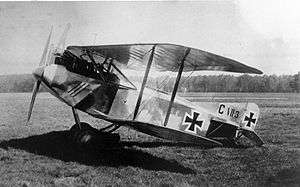AEG C.VII
| C.VII | |
|---|---|
 | |
| Role | Reconnaissance aircraft |
| National origin | German Empire |
| Manufacturer | Allgemeine Elektrizitäts-Gesellschaft[1] |
| First flight | December 1916[1] |
| Number built | 2[1] |
|
| |
.jpg)
AEG C.VII
The AEG C.VII was a prototype two-seat biplane reconnaissance aircraft of World War I. It was developed from the C.IV but did not enter production. The C.VII was tested with two different wing arrangements, one with slightly tapered single bay wings and another with sharply swept upper wing.[1]
Specifications (AEG C.VII)
Data from German Aircraft of the First World War[1]
General characteristics
- Crew: 2
- Length: 6.2 m (20 ft 4 in)
- Wingspan: 11.1 m (36 ft 5 in)
- Empty weight: 758 kg (1,671 lb)
- Gross weight: 1,118 kg (2,465 lb)
- Powerplant: 1 × Mercedes D.III 6-cyl water-cooled in-line piston engine, 119 kW (160 hp)
Performance
- Maximum speed: 165 km/h (103 mph; 89 kn)
- Rate of climb: 4.17 m/s (821 ft/min)
- Time to altitude: 1,000m (3,282ft) in 4min
Armament
- Guns: * 1 × forward-firing 7.92 mm (.312 in) LMG 08/15 machine gun
- 1 × 7.92 mm (.312 in) Parabellum MG14 machine gun in ring mount for observer
See also
- Related development
- Related lists
References
Further reading
| Wikimedia Commons has media related to AEG aircraft. |
- Kroschel, Günter; Stützer, Helmut: Die deutschen Militärflugzeuge 1910-18, Wilhelmshaven 1977
- Munson, Kenneth: Bomber 1914–19, Zürich 1968, Nr. 20
- Nowarra, Heinz: Die Entwicklung der Flugzeuge 1914-18, München 1959
- Sharpe, Michael: Doppeldecker, Dreifachdecker & Wasserflugzeuge, Gondrom, Bindlach 2001, ISBN 3-8112-1872-7
This article is issued from Wikipedia - version of the 4/4/2016. The text is available under the Creative Commons Attribution/Share Alike but additional terms may apply for the media files.